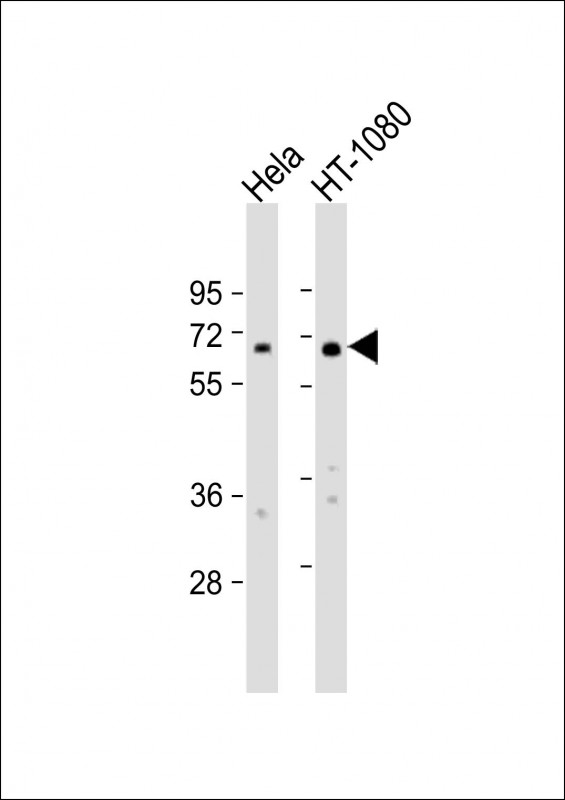IL4I1 Antibody (C-Term)
Purified Rabbit Polyclonal Antibody (Pab)
- 产品详情
- 实验流程
- 背景知识
Application
| WB, E |
|---|---|
| Primary Accession | Q96RQ9 |
| Reactivity | Human |
| Host | Rabbit |
| Clonality | polyclonal |
| Isotype | Rabbit IgG |
| Calculated MW | 62881 Da |
| Gene ID | 259307 |
|---|---|
| Other Names | L-amino-acid oxidase, LAAO, LAO, 1.4.3.2, Interleukin-4-induced protein 1, IL4-induced protein 1, Protein Fig-1, hFIG1, IL4I1, FIG1 |
| Target/Specificity | This IL4I1 antibody is generated from a rabbit immunized with a KLH conjugated synthetic peptide between 391-422 amino acids from human IL4I1. |
| Dilution | WB~~1:2000 E~~Use at an assay dependent concentration. |
| Format | Purified polyclonal antibody supplied in PBS with 0.09% (W/V) sodium azide. This antibody is purified through a protein A column, followed by peptide affinity purification. |
| Storage | Maintain refrigerated at 2-8°C for up to 2 weeks. For long term storage store at -20°C in small aliquots to prevent freeze-thaw cycles. |
| Precautions | IL4I1 Antibody (C-Term) is for research use only and not for use in diagnostic or therapeutic procedures. |
| Name | IL4I1 {ECO:0000303|PubMed:16029492} |
|---|---|
| Function | Secreted L-amino-acid oxidase that acts as a key immunoregulator (PubMed:17356132, PubMed:32818467, PubMed:32866000). Has preference for L-aromatic amino acids: converts phenylalanine (Phe), tyrosine (Tyr) and tryptophan (Trp) to phenylpyruvic acid (PP), hydroxyphenylpyruvic acid (HPP), and indole-3-pyruvic acid (I3P), respectively (PubMed:17356132, PubMed:32818467, PubMed:32866000). Also has weak L-arginine oxidase activity (PubMed:26673964). Acts as a negative regulator of anti-tumor immunity by mediating Trp degradation via an indole pyruvate pathway that activates the transcription factor AHR (PubMed:32818467, PubMed:32866000). IL4I1-mediated Trp catabolism generates I3P, giving rise to indole metabolites (indole-3-acetic acid (IAA) and indole-3-aldehyde (I3A)) and kynurenic acid, which act as ligands for AHR, a ligand-activated transcription factor that plays important roles in immunity and cancer (PubMed:32818467, PubMed:32866000). AHR activation by indoles following IL4I1-mediated Trp degradation enhances tumor progression by promoting cancer cell motility and suppressing adaptive immunity (PubMed:32818467). Also has an immunoregulatory function in some immune cells, probably by mediating Trp degradation and promoting downstream AHR activation: inhibits T-cell activation and proliferation, promotes the differentiation of naive CD4(+) T-cells into FOXP3(+) regulatory T- cells (Treg) and regulates the development and function of B-cells (PubMed:17356132, PubMed:25446972, PubMed:25778793, PubMed:28891065). Also regulates M2 macrophage polarization by inhibiting T-cell activation (By similarity). Also has antibacterial properties by inhibiting growth of Gram negative and Gram positive bacteria through the production of NH4(+) and H2O2 (PubMed:23355881). |
| Cellular Location | Secreted. Lysosome {ECO:0000250|UniProtKB:O09046}. Cytoplasmic vesicle, secretory vesicle, acrosome. Note=Secreted at the immunological synapse. |
| Tissue Location | Primarily found in immune tissues, with the highest expression in lymph nodes and spleen (PubMed:12031486, PubMed:12446450). Present in germinal center macrophages and inflammatory myeloid cells and antigen-presenting cells (at protein level) (PubMed:17356132). Also present in spermatozoa (at protein level) (PubMed:25767141). Highly expressed in primary mediastinal large B-cell lymphoma, a specific subtype of diffuse large B-cell lymphoma (PubMed:12446450). Expressed by neoplastic cells of several B-cell lymphomas and by tumor-associated macrophages (PubMed:19436310) |
For Research Use Only. Not For Use In Diagnostic Procedures.
Provided below are standard protocols that you may find useful for product applications.
BACKGROUND
Lysosomal L-amino-acid oxidase with highest specific activity with phenylalanine. May play a role in lysosomal antigen processing and presentation (By similarity).
REFERENCES
Chavan S.S.,et al.Biochim. Biophys. Acta 1576:70-80(2002).
Wiemann S.,et al.BMC Biol. 3:16-16(2005).
Chu C.C.,et al.Submitted (MAY-2005) to the EMBL/GenBank/DDBJ databases.
Jikuya H.,et al.Submitted (JAN-2002) to the EMBL/GenBank/DDBJ databases.
Clark H.F.,et al.Genome Res. 13:2265-2270(2003).
终于等到您。ABCEPTA(百远生物)抗体产品。
点击下方“我要评价 ”按钮提交您的反馈信息,您的反馈和评价是我们最宝贵的财富之一,
我们将在1-3个工作日内处理您的反馈信息。
如有疑问,联系:0512-88856768 tech-china@abcepta.com.























 癌症的基本特征包括细胞增殖、血管生成、迁移、凋亡逃避机制和细胞永生等。找到癌症发生过程中这些通路的关键标记物和对应的抗体用于检测至关重要。
癌症的基本特征包括细胞增殖、血管生成、迁移、凋亡逃避机制和细胞永生等。找到癌症发生过程中这些通路的关键标记物和对应的抗体用于检测至关重要。 为您推荐一个泛素化位点预测神器——泛素化分析工具,可以为您的蛋白的泛素化位点作出预测和评分。
为您推荐一个泛素化位点预测神器——泛素化分析工具,可以为您的蛋白的泛素化位点作出预测和评分。 细胞自噬受体图形绘图工具为你的蛋白的细胞受体结合位点作出预测和评分,识别结合到自噬通路中的蛋白是非常重要的,便于让我们理解自噬在正常生理、病理过程中的作用,如发育、细胞分化、神经退化性疾病、压力条件下、感染和癌症。
细胞自噬受体图形绘图工具为你的蛋白的细胞受体结合位点作出预测和评分,识别结合到自噬通路中的蛋白是非常重要的,便于让我们理解自噬在正常生理、病理过程中的作用,如发育、细胞分化、神经退化性疾病、压力条件下、感染和癌症。






